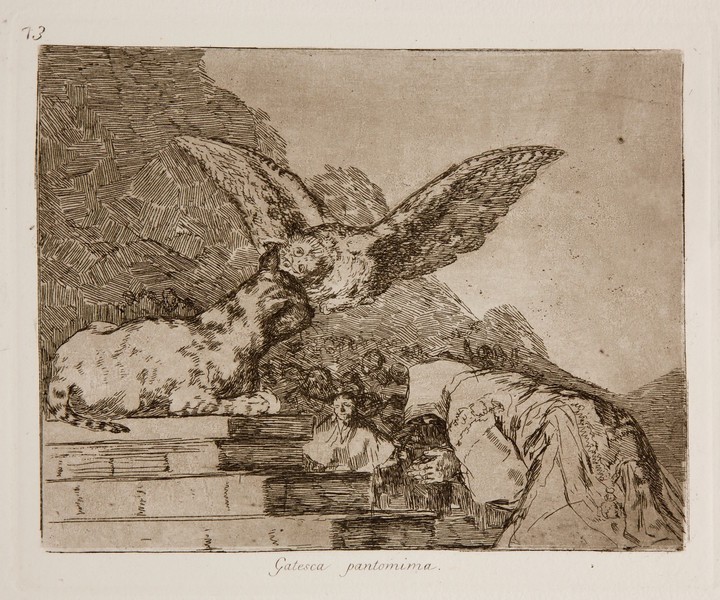- Cronología
- Ca. 1820 - 1823
- Dimensiones
- 179 x 219 mm
- Técnica y soporte
- Aguafuerte, buril y bruñidor
- Reconocimiento de la autoría de Goya
- Undisputed work
- Ficha: realización/revisión
- 28 Feb 2013 / 24 May 2023
- Inventario
- 225
See Sad forebodings of what is to come.
The title of the print was handwritten by Goya on the first and only series known to us at the time of its production, which the painter gave to his friend Agustín Ceán Bermúdez. Thus the title was subsequently engraved on the plate without any modification from Ceán Bermúdez's copy for the first edition of the Disasters of War published by the Royal Academy of Fine Arts of San Fernando in Madrid in 1863.
A preparatory drawing of this engraving is in the Prado Museum
On a flight of steps, Goya has engraved a cat in profile with its head slightly turned towards the background, approached in flight by an owl that seems to be whispering something in its ear. Next to them, with a hood over his head, we see a kneeling figure prostrating himself at the cat's feet; we do not know whether he is begging for mercy or worshipping him. In the background of the scene, in the central part of the engraving, we can make out a crowd of people, of which we can only discern a figure in the foreground.
As in other engravings in the Emphatic Caprices, it is really difficult to grasp clearly the deeper meaning of the image, possibly because it contains a strong criticism. The cat, possibly a symbol of cunning, is in a prominent position in relation to the rest of the figures in the print and is flattered by a friar who could allude to the Church. He is also being advised by an owl, which is usually identified with ignorance. This is probably a veiled allusion to Ferdinand VII, who has the support of the Church and surrounds himself with dubious sycophants and advisors who are not noted for their fine intelligence, but rather for their submissiveness.
Nigel Glendinning believes that, as with many other prints in The Emphatic Caprices, Goya may have been inspired by Giambattista Casti's (Viterbo or Acquapendente, 1724-Paris, 1803) Gli animali parlanti (1801). In it the owl represents the priest or servant of the God of the animals, a hypocritical religious man, with a kindly exterior appearance but underneath which hides a cruel personality that fosters fanaticism. It is likely that this figure had to do with Ferdinand VII and the climate that prevailed during his reign.
For Dérozier, however, both this engraving and the one that follows it, no. 74, This is the Worst, are a clear allusion to the despotic manner in which Ferdinand VII ruled.
The plate is in the National Chalcography (cat. 324).
-
De grafiek van GoyaRijksmuseum RijksprentenkabinetAmsterdam1970from November 13th 1970 to January 17th 1971cat. 86
-
Francisco de GoyaMuseo d'Arte ModernaLugano1996exhibition celebrated from September 22nd to November 17th.p.90, cat. 73
-
Francisco Goya. Sein leben im spiegel der graphik. Fuendetodos 1746-1828 Bordeaux. 1746-1996Galerie KornfeldBern1996from November 21st 1996 to January 1997cat. 163
-
Francisco Goya. Capricci, follie e disastri della guerraSan Donato Milanese2000Opere grafiche della Fondazione Antonio Mazzottacat. 153
-
Goya et la modernitéPinacothèque de ParisParís2013from October 11st 2013 to March 16th 2014cat. 112
-
Goya, grabadorBibliography']['numberMadridBlass S.A.1918cat. 175
-
Goya engravings and lithographs, vol. I y II.Bibliography']['numberOxfordBruno Cassirer1964cat. 193
-
Vie et ouvre de Francisco de GoyaBibliography']['numberParísOffice du livre1970cat. 1120
-
A solution to the enigma of Goya’s emphatic caprices nº 65-80 of The Disasters of WarApolloBibliography']['number1978pp.186-191
-
Catálogo de las estampas de Goya en la Biblioteca NacionalBibliography']['numberMadridMinisterio de Educación y Cultura, Biblioteca Nacional1996cat. 293
-
Bibliography']['number
ParísPinacoteca de París2013p. 156
-
Goya. In the Norton Simon MuseumBibliography']['numberPasadenaNorton Simon Museum2016pp. 114-151

